
Renovation of the Budapest Western train station
Mar 01, 2018 Read time: approx. MinutesMinute
Restoring the splendor of an imperial past
The Budapest Western train station is currently being lovingly restored. Now that it has been impregnated with an alpha-silane-terminated polyether, the faded terrazzo flooring is once more as radiant as in the days of the Austro-Hungarian Empire.
Lovers of revivalist architecture from the second half of the 19th century will find plenty to get excited about in Budapest, where entire streets and districts dating from the Austro-Hungarian Empire have survived fully intact and have been renovated and restored to their original style.
Funding from Brussels
The architectural gems of the Austro-Hungarian Empire include Budapest’s listed Western train station (Nyugati pályaudvar), which – thanks to EU funding – is being completely renovated and lovingly restored. “The aims of the restoration project included returning the terrazzo floors in some of the buildings to their original splendor,” explained Udo Goedecke, the marketing manager in charge of building-protection applications at WACKER SILICONES.
1877 saw the dedication of Budapest’s Western train station, which is known for the highly ornamental architectural style of the Austro-Hungarian Empire.
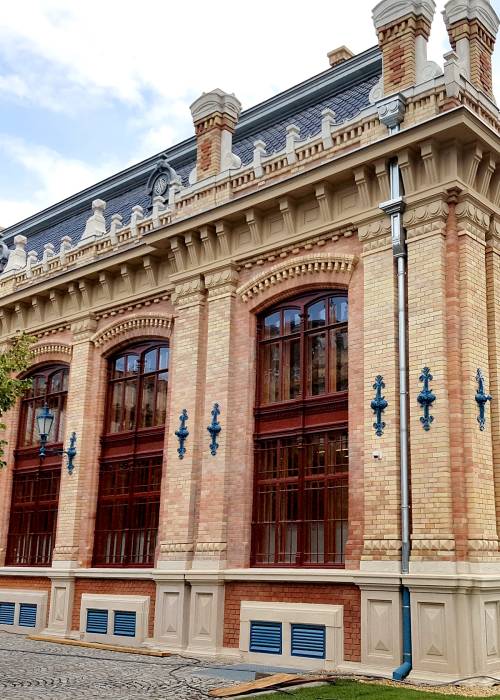
Now restored to its original style: the right wing of the train station with the pavilion that housed the former post office.
Trainshed by the Eiffel Company
Officially opened in 1877, the building was largely designed by August W. de Serres, a railroad engineer, who was chief architect at the Imperial Austrian railroad company at that time. The commission for detailed planning and building execution was given to the firm of Gustave Eiffel, who later designed the famous tower named after him in Paris. The steel-girder structure above the platforms was the work of Eiffel’s former partner Theophil Seyry.
As was common practice in the early days of the railroad, de Serres designed the terminus station so that trains arrived on one longitudinal site of the platform area, while passengers left on the other. The buildings at the departure end were particularly magnificent so that passengers making their way to the platforms from the adjacent forecourt were given a delightful and dignified send-off. Viewed from this forecourt, the buildings are arranged like the court of honor of a French-style Baroque palace.
Renewed Splendor for Flooring in Budapest Train Station

Brilliant copper inlays
The wing on the right-hand side of this courtyard is the pavilion that used to house the station post office. Its magnificent terrazzo floor features copper inlays, while narrow strips of copper accentuate the contrasting colors of the surface design – reddish-brown/pale gray and anthracite/gray. A cement screed holds the colored natural stone grain together, which experts refer to as a cementitious or cement-bound terrazzo. Once the renovations are complete, the city of Budapest wants to use the former post office pavilion as an agency for dealing with ID and passport matters.
In general, a cementitious terrazzo floor is considered to be hard wearing and durable. When in use, however, this kind of floor is more sensitive than it looks. There are two reasons for this: first, the hardness of each terrazzo component varies. As people walk over the floor, the softer cement wears down more quickly than the harder stone aggregates. Second, the terrazzo floor has a porous surface.
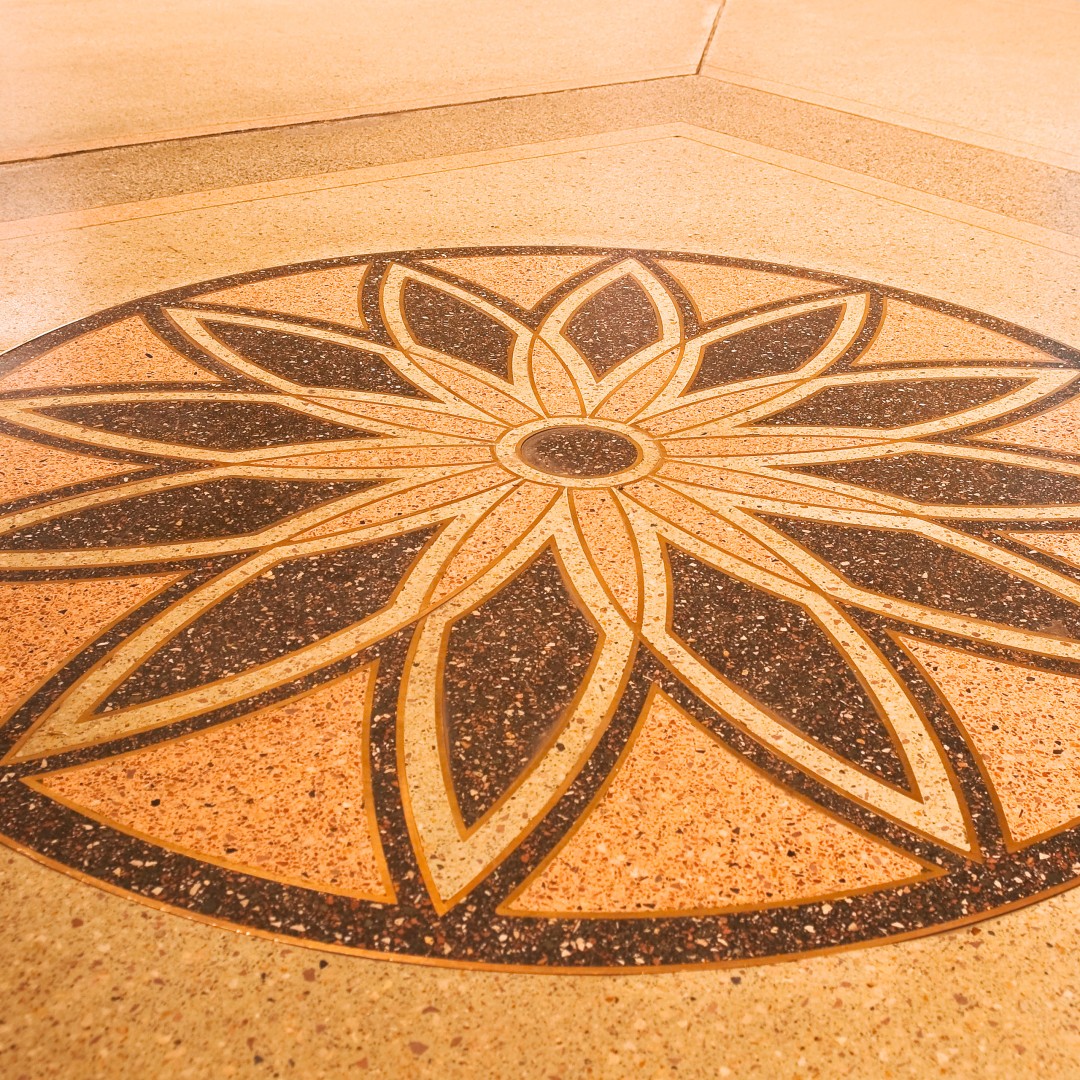
Impregnation does an especially nice job of bringing out the patina of the 140-year-old terrazzo flooring.
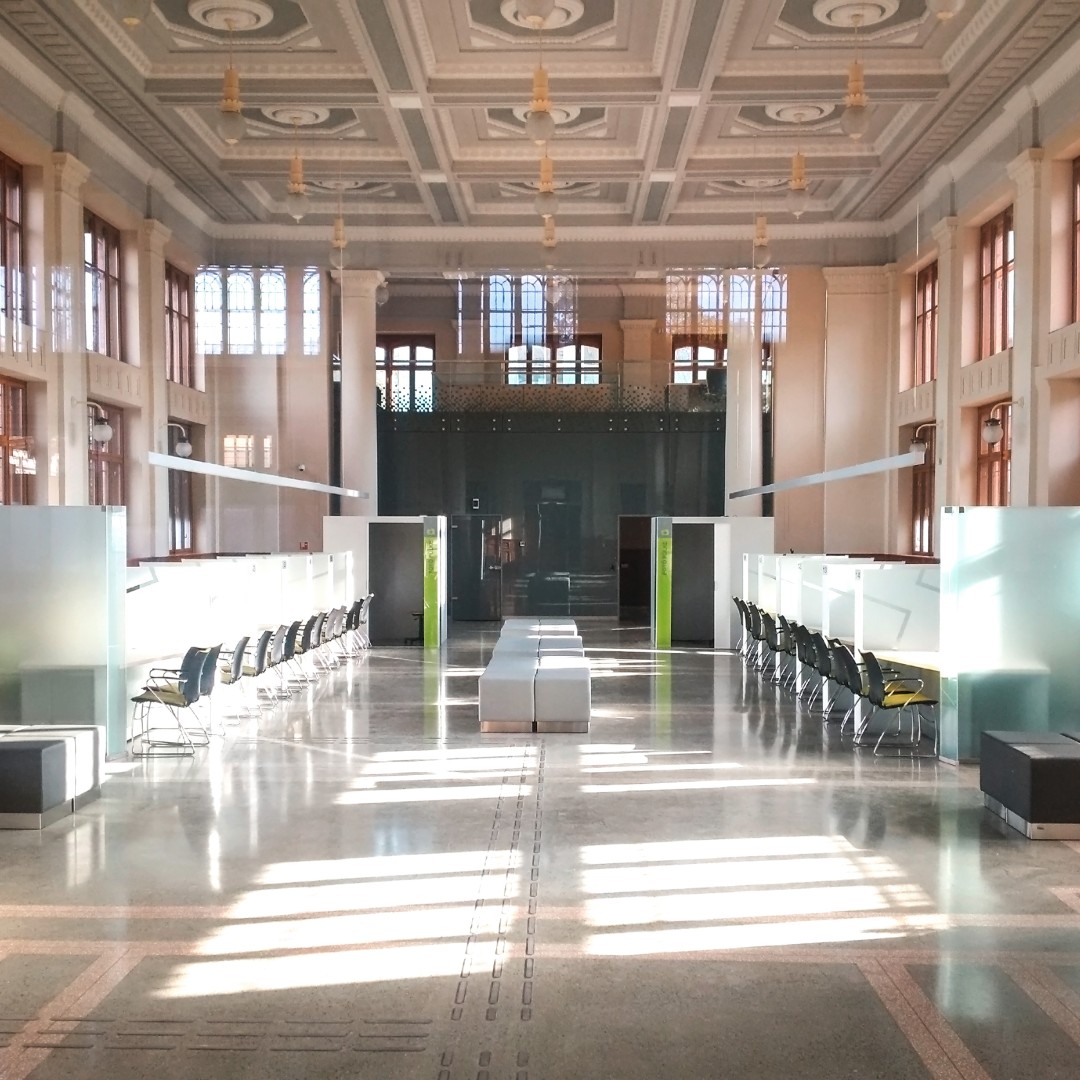
Impregnation gives the terrazzo floor the same splendor and beautiful patina as before.
Terrazzo
The term ‘terrazzo’ describes a type of flooring known since antiquity in which a decorative and often colorful aggregate is applied directly to a cement-bound screed bed to form a single material. After drying, the surface of the terrazzo is ground and polished to its final gloss. The years of the Austro-Hungarian Empire, from the late 19th to the early 20th centuries, were when terrazzo flooring was used most widely, and not just in homes – it was also common in public buildings such as churches and train stations. These floors often featured combinations of surfaces in different colors, as well as ornaments or inscriptions made of mosaic tiles, as was the case in Budapest’s Western train station. Source: Wikipedia
A porous surface
“As a result of its porosity, the surface absorbs spilled drinks, oils and other liquids. This produces dirt marks that are very difficult to remove completely,” explained WACKER building-protection expert Udo Goedecke. What’s left are unpleasant stains and – in the case of considerable abrasion – visible traffic areas, which disfigure the floor. “So it’s sensible to protect a terrazzo floor,” he advises.
The planners responsible for restoring the floor in the former post office likewise had to tackle this challenge. Initially, they decided to treat the floor with a polyurethane-based product. Aesthetically speaking, their decision turned out to be the wrong one, as the treated surface looked artificial, taking on a matte and dull appearance – which satisfied neither property developer nor architect.
The Decision to Use SILRES® BS 6920
The developer contacted Durostone Kft. for advice. Located in the Budapest suburb of Sóskút, this company specializes in the manufacture and restoration of industrial flooring. Durostone’s development engineer, Péter Árva, recommended sanding off the polyurethane layer that had been applied to the test surface of the floor and treating it instead with an impregnation agent based on SILRES® BS 6920.
SILRES® BS 6920 is a new, clear liquid and low-viscosity binder that belongs to the group of alpha-silane-terminated polyethers. WACKER scientists had optimized it specifically for the impregnation of cementitious floors. In combination with an aminosilane catalyst such as WACKER’s GENIOSIL® GF 9, it can be processed to one-component, solvent-free and odorless formulations. These formulations adhere well to cementitious surfaces and, when exposed to atmospheric humidity, cure quickly, forming a stable siloxane network.
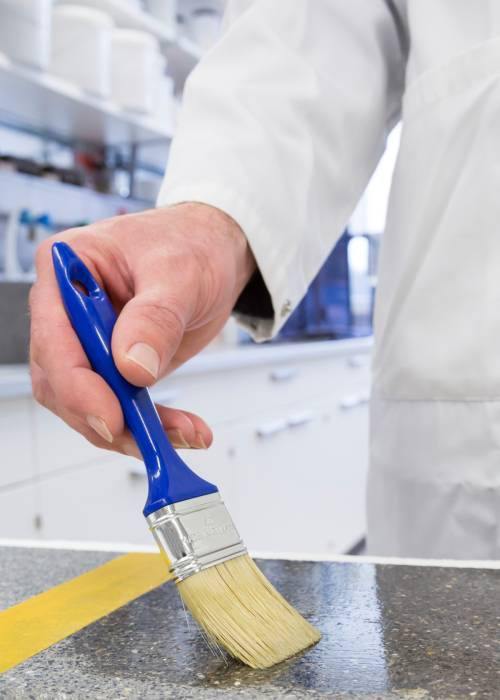
Test sample: SILRES® BS 6920 is brushed onto a test sample made of cement and aggregate stones.
Binder Fills Pores
The binder penetrates deep into the cementitious floor, filling the pores and curing to a hard and non-combustible material that has both water-repellent and oil-resistant properties thanks to its chemical molecular structure. “An impregnation agent based on our new binder greatly improves the floor’s resistance to rub off and scratches. It also affords really good stain protection,” said Dr. Udo Anders, in charge of technical support for this product group at WACKER SILICONES.
What’s more, SILRES® BS 6920 improves the surface appearance, as Dr. Anders explains: “If the SILRES® BS 6920 formulation is transparent, it intensifies the surface coloring and brings out the contrasts so that the treated floor looks darker and the appearance of its aggregate is emphasized. The surface is also given a slight sheen, which emphasizes the quality of the floor. We have conducted a large number of tests in our applications lab to prove all these effects.”
Immediately Ready to Use
It is precisely this property profile that motivated Durostone development engineer Péter Árva to process the new binder into a ready-to-use impregnation agent (Durosmart Floorprotect S). This agent was ultimately used to treat the approximately 300 square meters of terrazzo flooring in July 2017.
“The sanded-down floor was in an excellent state,” recalled Goedecke, who went on to say: “On our advice, the applicator team decided to apply two coats and to dilute the Durostone impregnation agent intended for the first coat with 10% SILRES® BS 1701 reactive thinner.” In this way, about 50 grams of the diluted formulation were to be applied as an initial coat and then as a second coat to each square meter of the terrazzo floor.
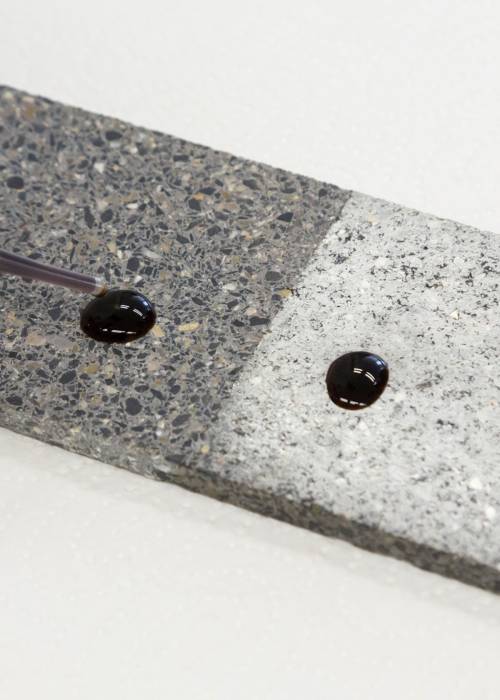
Contamination: A technician then drips contaminants such as engine oil onto the impregnated (left) and non-impregnated surfaces.
The Viscosity of Water
The reactive thinner makes it possible to adjust the formulation’s viscosity to almost match that of water. As a result, the agent can be spread over the surface particularly well. In addition, the greatly diluted agent remains workable for a lot longer. The applicator therefore has enough time to process the material properly.
The odorless SILRES® BS 1701 reactive thinner is a low-viscosity silane incorporated into the resultant siloxane network during curing. “A diluted impregnation agent makes the initial coat particularly effective,” says Goedecke. “The applicators can stir the thinner into the impregnation agent on site.”
In many cases, a second coat is needed to ensure that the surface looks even, the reason being that the porous floor absorbs a large amount of the impregnation agent applied as an initial coat. Some spots absorb a considerable amount of agent, while others absorb much less. This is why the surface often looks stained or uneven after application of the first coat. That changes with the second coat, which forms a thin, slightly glossy film.
After application of two coats, everyone is happy with the result: the surface was completely even, with a high-class finish, according to Zoltán-Gábriel Géza, sales manager at WACKER Hungary. “The once faded terrazzo now looks natural and fresh once again, while the high contrast between its coloring and ornamental features has been shown to advantage.”
“Everyday liquids – whether waterborne or oily – are no longer able to penetrate into the treated surface and can easily be wiped away using a paper towel.”
Dr. Udo Anders, in charge of technical support for this product group at WACKER SILICONES
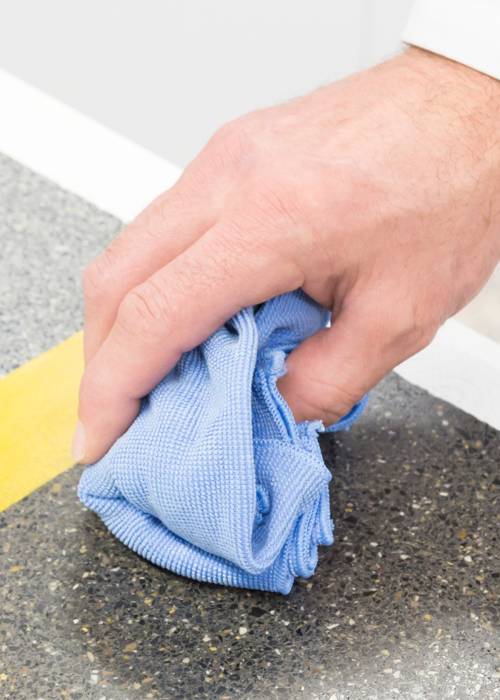
Just wipe: The protective effect of the impregnation becomes apparent when the contaminants are wiped away.
A Natural, High-Quality Finish
Durostone’s flooring expert was delighted. Árva explained: “It’s exactly this natural and high-quality finish that influenced me to choose the new SILRES® BS 6920 binder straight away. Another factor in its favor was that it is extremely simple to process so as to obtain a ready-to-use product: all the components – including the thinner – needed for production are simplicity itself to mix. So, I can very quickly supply a customer with a tailored floor anti-stain impregnation.”
The comments of the applicators were positive, too. They were impressed that both processing and the look of the floor produced excellent results in spite of the very small amount of agent applied. They also mentioned how easy it was to apply the low-viscosity agent, and were full of praise for its lack of odor. Finally, Árva was not just appreciative of the quality of the product itself: “Because WACKER had provided us with extensive technical support beforehand, there were no doubts whatsoever about using the impregnation agent on such an architectural jewel.”
Mr. Udo Goedecke
Senior Marketing Manager
Construction Silicones
+49 89 6279-1055
udo.goedecke@wacker.com
